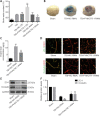Inhibiting phosphatase and actin regulator 1 expression is neuroprotective in the context of traumatic brain injury
- PMID: 36571365
- PMCID: PMC10075113
- DOI: 10.4103/1673-5374.357904
Inhibiting phosphatase and actin regulator 1 expression is neuroprotective in the context of traumatic brain injury
Abstract
Studies have found that the phosphatase actin regulatory factor 1 expression can be related to stroke, but it remains unclear whether changes in phosphatase actin regulatory factor 1 expression also play a role in traumatic brain injury. In this study we found that, in a mouse model of traumatic brain injury induced by controlled cortical impact, phosphatase actin regulatory factor 1 expression is increased in endothelial cells, neurons, astrocytes, and microglia. When we overexpressed phosphatase actin regulatory factor 1 by injection an adeno-associated virus vector into the contused area in the traumatic brain injury mice, the water content of the brain tissue increased. However, when phosphatase actin regulatory factor 1 was knocked down, the water content decreased. We also found that inhibiting phosphatase actin regulatory factor 1 expression regulated the nuclear factor kappa B signaling pathway, decreased blood-brain barrier permeability, reduced aquaporin 4 and intercellular adhesion molecule 1 expression, inhibited neuroinflammation, and neuronal apoptosis, thereby improving neurological function. The findings from this study indicate that phosphatase actin regulatory factor 1 may be a potential therapeutic target for traumatic brain injury.
Keywords: apoptosis; aquaporin 4; blood brain barrier; intercellular adhesion molecule 1; neuroinflammation; nuclear factor kappa B; occludin; phosphatase and actin regulator-1; traumatic brain injury; zonula occludens 1.
Conflict of interest statement
None
Figures








References
-
- Abbott NJ, Patabendige AA, Dolman DE, Yusof SR, Begley DJ. Structure and function of the blood-brain barrier. Neurobiol Dis. 2010;37:13–25. - PubMed
-
- Allain B, Jarray R, Borriello L, Leforban B, Dufour S, Liu WQ, Pamonsinlapatham P, Bianco S, Larghero J, Hadj-Slimane R, Garbay C, Raynaud F, Lepelletier Y. Neuropilin-1 regulates a new VEGF-induced gene, Phactr-1 , which controls tubulogenesis and modulates lamellipodial dynamics in human endothelial cells. Cell Signal. 2012;24:214–223. - PubMed
-
- Bieber M, Gronewold J, Scharf AC, Schuhmann MK, Langhauser F, Hopp S, Mencl S, Geuss E, Leinweber J, Guthmann J, Doeppner TR, Kleinschnitz C, Stoll G, Kraft P, Hermann DM. Validity and reliability of neurological scores in mice exposed to middle cerebral artery occlusion. Stroke. 2019;50:2875–2882. - PubMed
LinkOut - more resources
Full Text Sources

